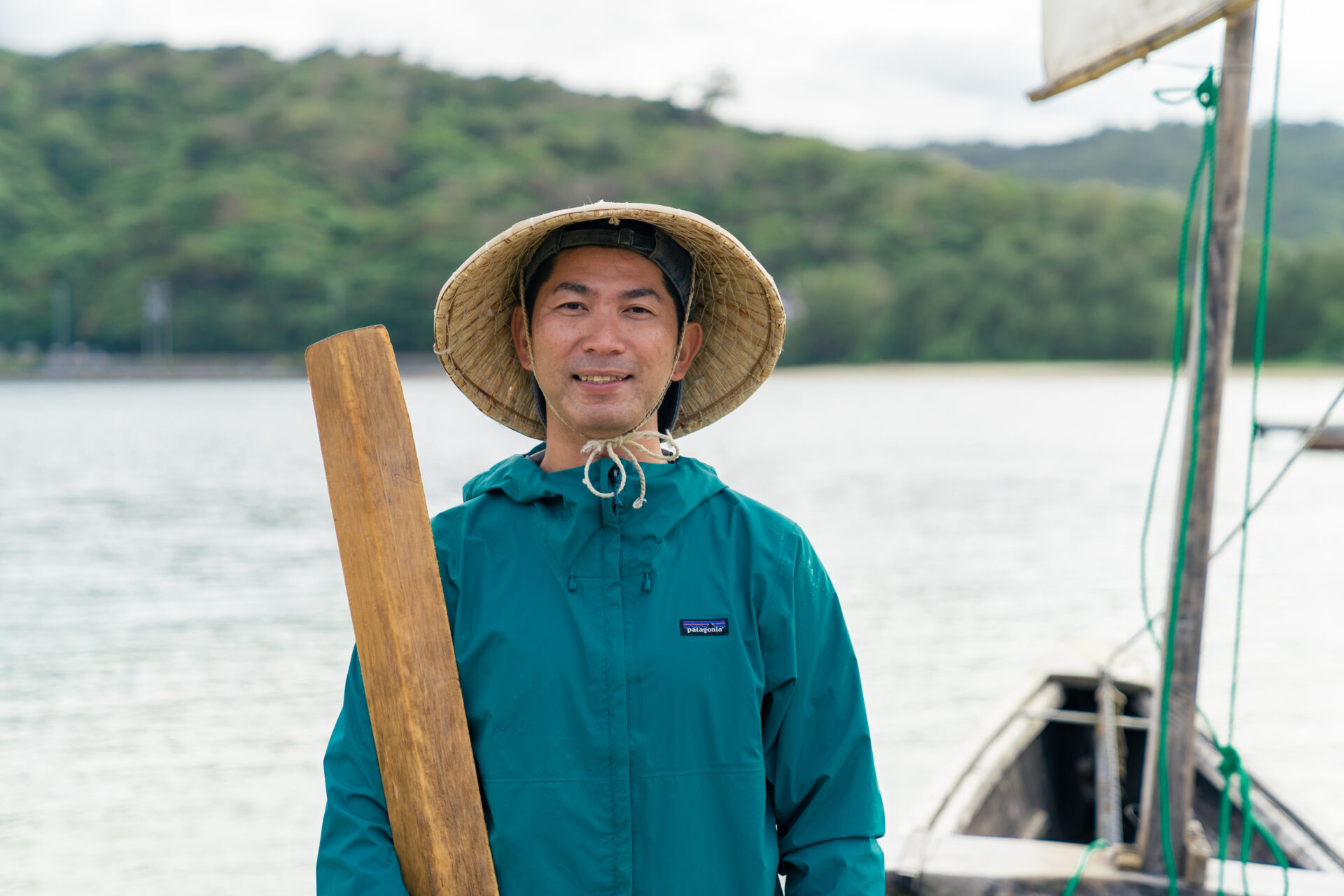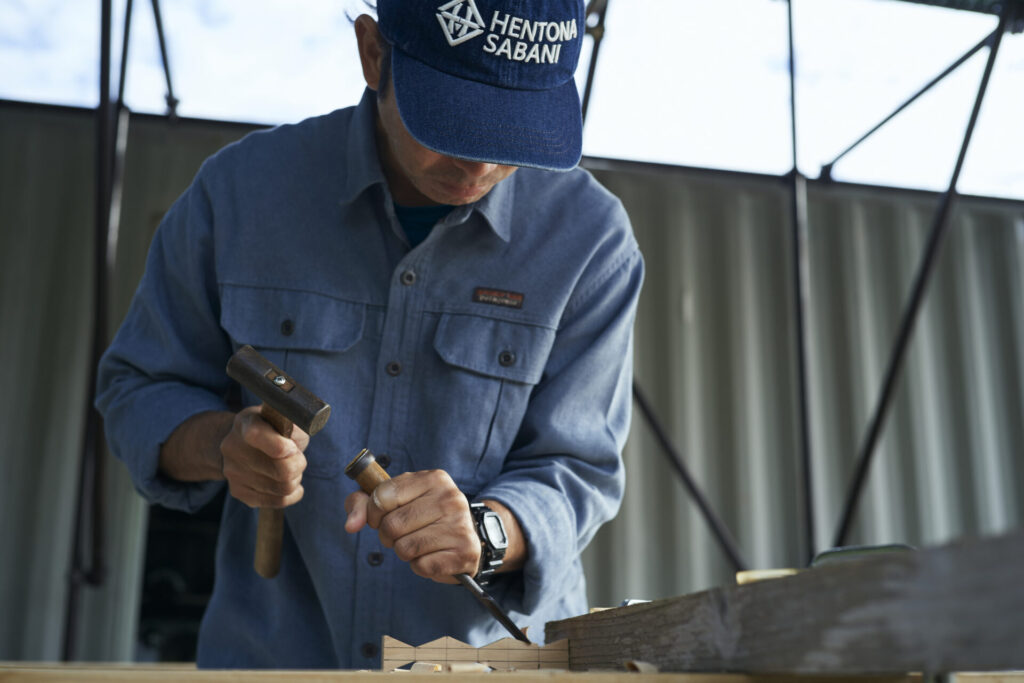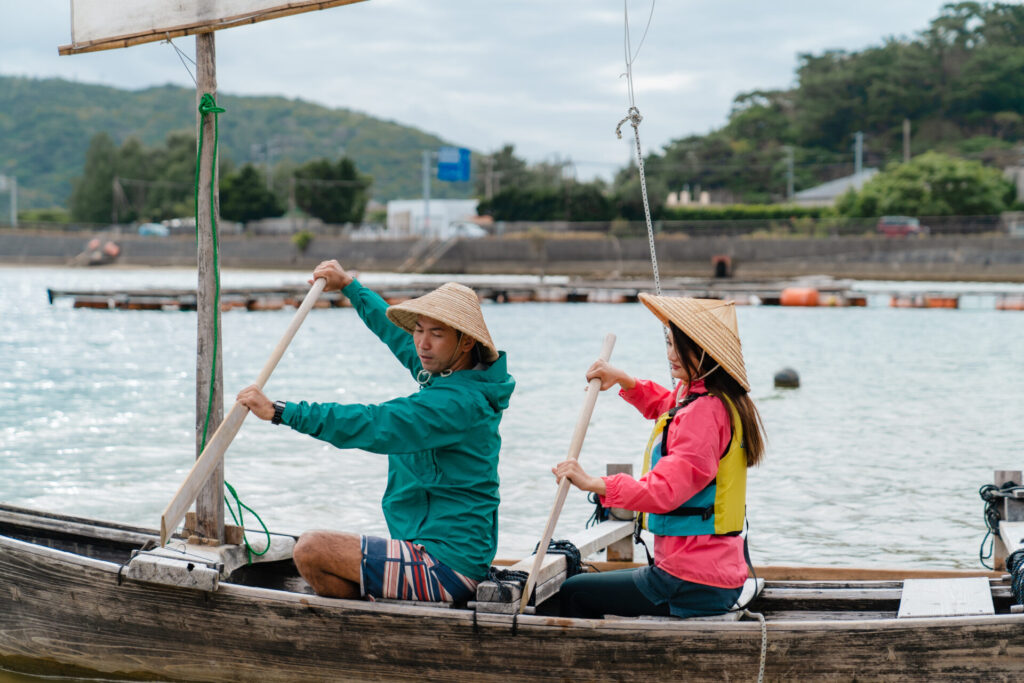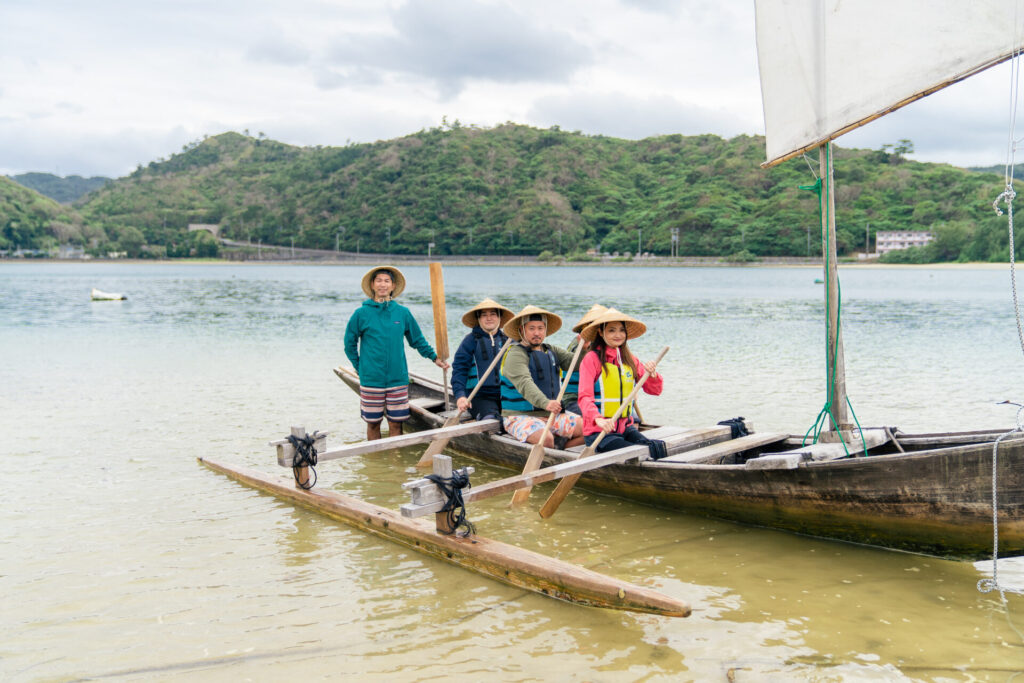
The “Sabani” That Changed My Life Is a Boat That Brings People Joy

邊土名 徹平
Teppei Hentona
Oogimi [Okinawa]
Teppei Hentona
Born in Urasoe City, Okinawa. Representative of Hentona Sabani. Based in Ōgimi Village, he builds sabani, Okinawa’s traditional wooden sailing boats, while also running sabani cruise tours. While working in tourism on Ishigaki Island, he encountered the sabani and was captivated by its beauty and cultural value, going on to inherit its traditional techniques. In 2020 he moved to Ōgimi and became independent, continuing activities that share Okinawa’s nature and culture.
From Shioya Bay in Ōgimi Village, Okinawa, boatbuilder Teppei Hentona sets out in a traditional wooden sailing boat called a sabani. One encounter with a single vessel, discovered while he worked in tourism, changed the course of his life and eventually led him to base himself in Ōgimi, the home of his roots. Days spent building, piloting, and passing on the sabani. With deep gratitude to his hometown, Hentona shares his hope of carrying this craft into the future. We spoke with him in detail.
Instantly Captivated by the Beauty of a Sabani Floating on the Okinawan Sea
From Shioya Bay, a single sailboat glides slowly out toward the open water. The rower wears a kuba-gasa—a hat woven from the leaves of the kuba (Livistona) palm—reading the wind that fills the sail as he pulls the water with broad strokes of an ēku (oar). There’s another rower aboard, and a small boy. The scene recalls a time, decades ago, when boats were part of everyday life.
We are on Miyagi Island in Ōgimi Village, in the northern part of Okinawa’s main island, a region rich in nature known as Yanbaru. Aboard the boat is the family of Teppei Hentona, who maintains a workshop on the island.
The boat—sabani—is Okinawa’s traditional wooden sailing craft, propelled by wind and ēku. Hentona is both its maker and the captain who guides sabani cruise tours.
“I first encountered the sabani while working in tourism on Ishigaki Island. The moment I saw it floating on the sea, I was instantly captivated by how beautiful it was. I was moved by the quiet presence of a boat made from natural materials.”

At the time, Hentona worked for a travel company, uncovering tourism resources to share the charms of the Ishigaki area with Japan and the world. One place he visited among the Yaeyama Islands was the workshop of master sabani builder Tomoatsu Yoshida.
“I felt in my gut that this was the work I’d been searching for—something that could contribute to Okinawa. I forgot myself and blurted out to Mr. Yoshida, who would later become my teacher, ‘I want to try building one of these boats.’” Hentona recalls with a laugh.
That meeting with the sabani was what changed Hentona’s life.
Soccer, Music, and Then Tourism—Driven by a Wish to Give Back to His Home
“As a kid, I was all about soccer—right through junior high.”
He spent his youth sprinting across the pitch. In junior high he picked up the guitar and became absorbed in music. In high school he formed a band with friends and began performing original songs. They gigged constantly, and by his early twenties the band had grown enough that their CDs appeared not only in Okinawa shops but on Tokyo shelves as well.
Alongside the band, Hentona worked part-time at a CD and video rental shop. There he discovered the joy of customer service—of making people happy. It was also when he began to feel ready to bring the band chapter to a close.
“Hearing customers say ‘thank you’ made me happy, so I decided to commit to the world of service. At the time, the pinnacle of service work I could imagine was in hotels. I joined a major hotel chain with locations nationwide and spent about ten years gaining experience at branches across Japan.”
Even then, he held a desire to one day contribute to Okinawa, a tourism-oriented prefecture—to give back to the home that raised him.
That resolve sent him to Canada. Because Okinawa welcomes many overseas visitors, he wanted to gain the English skills essential for communication and to broaden his perspective as someone working in tourism.
“Canada is an immigrant country, home to people with diverse roots and cultures. I jumped into that world—joining pickup soccer games in parks with people from all over, trying surfing in the U.S., and mixing with all kinds of folks.
What I felt there was diversity—the value that it’s natural for everyone to be different. That opened up my world.”
After his one-year visa ended, he returned to Okinawa without hesitation, carrying the wish to contribute through tourism. Putting his Canadian experience to work, he joined a travel company on Ishigaki Island—and there he had his fateful encounter with the sabani. The values he’d honed in Canada seemed to push him toward his next step.
Days as a “Sabani Carpenter” Carrying on a Tradition on the Brink of Disappearing
Leaving the travel company, Hentona apprenticed under Mr. Yoshida and began his path as a sabani carpenter. Though he had grown up in Okinawa, this was his first time truly facing the sabani.
Tracing the sabani’s history, about 150 years ago it evolved from dugout canoes carved from large logs into boats assembled from multiple planks. They were used for a wide range of purposes, including fishing and transport. But from the 1950s on, with the spread of engines and the advent of FRP (fiber-reinforced plastic) boats, wooden sailing sabani rapidly vanished.
“Orders dwindled, and the number of sabani carpenters dropped. I’ve heard that, if things had continued that way, the craft could have died out completely.”
A turning point came in 2000, when the Sabani Sail & Row Race began, crossing roughly 36 kilometers from Zamami Island to Naha. Interest surged again, and orders for new boats grew as teams sought to compete, which helped preserve the boatbuilding skills. It was thanks to that current that Hentona was able to learn under Mr. Yoshida.
Even so, mastering the techniques was anything but easy. Sabani are built using a distinctive method without metal nails, joining multiple timbers with butterfly-shaped wooden keys (chigiri) and bamboo pegs. To complete a single boat, one must craft and drive about 250 chigiri and 500 bamboo pegs one by one. The wood must be joined with high precision, or the seams will leak and the boat will be unusable. What kept Hentona going was his feeling for the Okinawa that had nurtured him.


“In every step, you can feel the wisdom of those who came before us. If I can learn the skills and pass them to the next generation, I felt I could, in my own way, contribute to Okinawa.
There’s a sense of purpose and romance in shaving wood with your own hands, building a boat, and rowing out onto the open sea. That’s why I even enjoy the steady, painstaking work.”
In 2020, after completing his training, Hentona chose Miyagi Island in Ōgimi Village as his base as a sabani carpenter.
Discovering His Own Roots Through the Sabani
While training on Ishigaki, Hentona learned something about his own family: his ancestors had lived on Miyagi Island for over 200 years.
In 1955, responding to a postwar population boom, his grandfather Chōkō Hentona led about 350 people in a settlement project to relocate to Ishigaki Island. Hentona’s father was born on Miyagi Island and spent his childhood through junior high on Ishigaki before moving to southern Okinawa’s main island, which meant Teppei himself grew up with little connection to Miyagi or Ishigaki.
By chance, while working for the travel company on Ishigaki as an adult, he found himself in the very village his grandfather’s group had established. Locals told him, “You’re Chōkō Hentona’s grandson, aren’t you? Thanks to his persistent negotiations back then, we have this village today.” Seeing his grandfather’s achievements with his own eyes made him acutely aware of his roots.
“It felt like I was being guided by my ancestors. I saw my grandfather’s name carved in stone and his photo displayed at the community hall, and people I’d never met treated me with warmth. I couldn’t help but feel grateful.”
During his training, a neighbor—also from Ōgimi and likewise among the settlers who had moved to Ishigaki—told him, “Your hometown is Ōgimi. If you do sabani on Shioya Bay, that’d be the best.”
Shioya Bay, which he visited as if retracing history, is embraced by abundant nature and holds memories stretching back generations. “Maybe carrying on tradition here is my calling,” he felt, and decided to set up independently on Miyagi Island in Ōgimi.
The community welcomed him warmly. When he tended his boat on the beach, elders reminisced about the old fishery days, calling out, “Brings back memories.” When he raised sail and ran before the wind, people smiled, saying, “It’s the very picture of the past.” Though he has no close relatives nearby, many have embraced him with familiarity as one of the “Hentona clan,” cheering him on.
“By chance I’ve met so many people, and I’ve been guided here as if following in the steps of my grandfather and father—to build sabani and live. I feel truly fortunate.”
Feeling the Sea’s Abundance and the Lives of Our Ancestors Through Sabani
Among the communities around Shioya Bay, one of the biggest annual events is Ungami (Sea Deity Festival), designated by Japan as an Important Intangible Folk Cultural Property. Prayers are offered for good catches and bountiful harvests. Harī (dragon boats) painted in vivid colors are rowed by teams of men who race by settlement, while women welcome the boats back to shore with drums and song.
Hentona shares this hometown tradition in an accessible way with participants on his sabani cruises—along with the sabani’s history and inherited techniques.
“There are many marine activities people enjoy today, but I think feeling the Okinawan sea in a boat born and nurtured in Okinawa is a unique charm of the sabani. While on the water, you can also reflect on local history and the lives of those who came before us.
Of course, the exhilaration of running on the power of the wind is another attraction. When you glide smoothly over the sea, feeling the warmth of the wood and the touch of the breeze, it’s like becoming one with the earth.”

When the wind drops, everyone becomes a rower. Adults and children take up the ēku, call out together, and pull in unison. Kids who were shy at first find themselves raising their voices and smiling as they handle the oar. Children who are usually reserved open up with surprising ease and enjoy themselves. What’s born there is a sense of togetherness. Okinawa’s beautiful sea and the warmth of the wooden sabani nurture that connection. Wrapped in grand nature, people may return to their truest selves.
What Do You Want to Pass On to the Future?
Finally, we asked Hentona what he wants to carry forward.
“To pass the culture of the sabani to the next generation. First, I want to share its appeal so people know that such a wonderful boat exists. Personally, I want to keep refining my skills as a sabani carpenter.
I’m still just starting out, but if, in time, I can pass on the techniques and contribute to my hometown, nothing would make me happier. I’ll keep working to become a craftsman others can look up to. I hope the number of people who carry on this tradition grows, even little by little.”
Hentona met the sabani, discovered his roots, and along the way started a family. Now he rows out to sea with his wife and son, savoring the great outdoors.
“The sabani that changed my life so profoundly is, I believe, a boat that brings happiness. If more people can experience the sabani and catch a fair wind in their own lives, I’d be delighted.”
From his words, you feel a deep love for—and pride in—Okinawa, along with a strong will to carry on tradition. Yet his expression doesn’t convey a rigid sense of duty so much as a desire to walk forward with a clear purpose—and the hope to live openly and expansively in the place he calls home.

